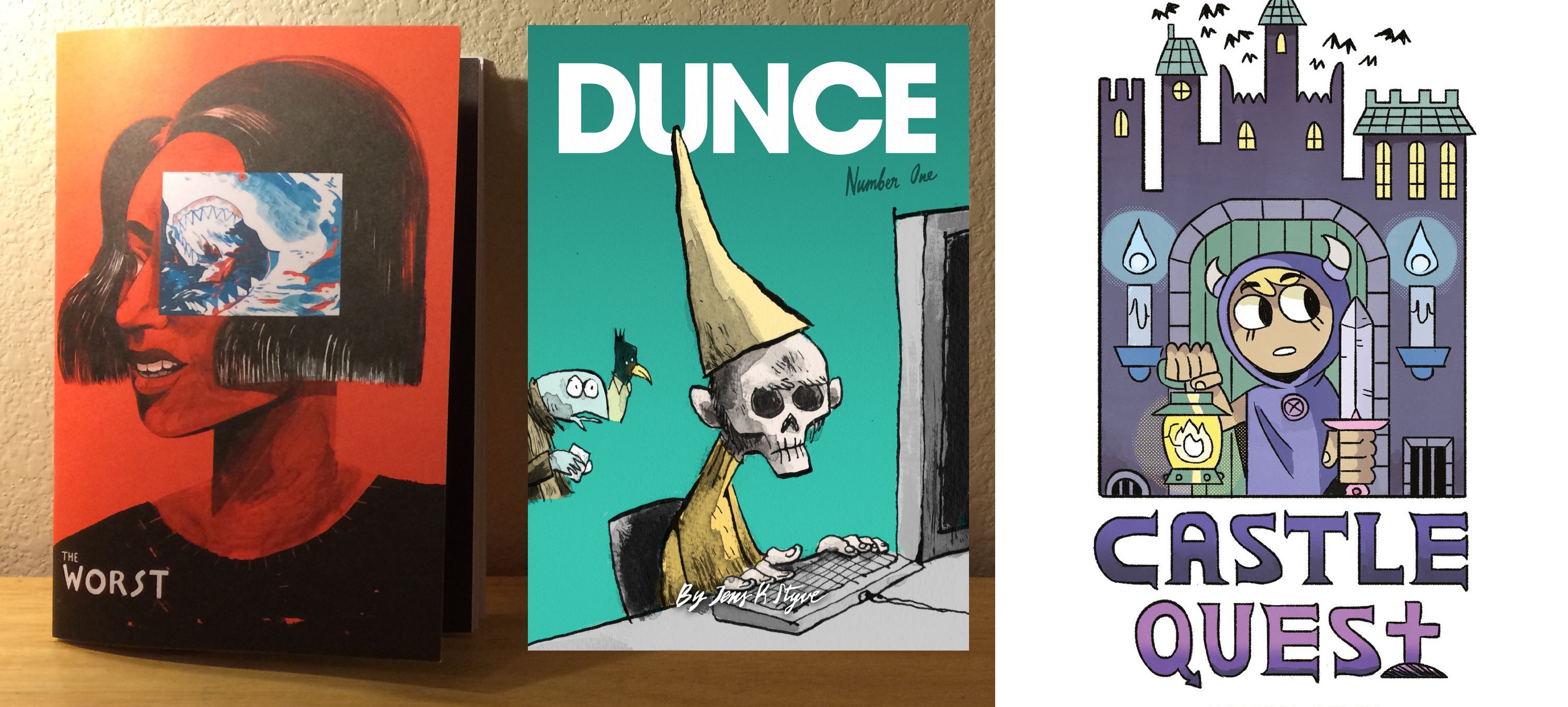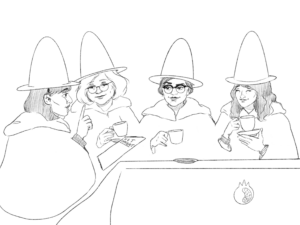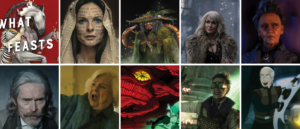
Castle Quest – Matthieu Cousin
Who doesn’t enjoy a good quest? Especially when terror and whimsy are as superbly balanced as they are in this comics homage to video games like Castlevania and Dark Souls. The set-up for Castle Quest is fairly standard. A darkness has covered the land and a mysterious castle is said to be at its root. A brave girl approaches that castle, clad with a horned cape and shortsword, in search of quest for her missing family. Just outside the walls, she encounters a dying soldier who gifts her a magical, talking lantern named Aduro. Together, the girl and Aduro brave the castle’s depths and uncover the source of the evil lurking within it. Castle Quest doesn’t discover any new lands, but it walks its familiar path with enough confidence and care that it feels fresh again anyway.

One of the things Cousin does best here is pacing. The comic moves briskly, and while there aren’t really any quiet moments, Castle Quest never feels rushed. Cousin always gives each scene space to be sufficiently realized, then smoothly transitions it into the next one so as to keep up the momentum. One way Cousin manages this is simple page length. At 50 pages, Castle Quest can afford to spend 3 of them early on at the castle’s door. Another way is generous use of location-establishing panels. Even hurtling along, the reader always has a solid sense of where in the castle they are. This last point is especially important, because Castle Quest‘s sense of exploration (linear though it may be) is as important as its story.

Another one of Castle Quest’s delights is the character design. Cousin relies on a lot of genre tropes (tiny devils, zombie dogs, a vampire queen) but he executes them all excellently and occasionally outright improves upon them. The manga influence is there, of course, as are the darkly-shaded supernatural creatures of Mike Mignola. But in the geometric cutesiness of my favorite character, Aduro the Lantern, I also detect the influence of more graphic design-y midcentury American cartoons (e.g. early Hanna-Barbera or this ad). I wouldn’t have been surprised (or disappointed, really) if Aduro had ultimately led the protagonist to a box of cereal.

In fact, a bowl of sugar cereal might be the perfect accompaniment to Cousin’s comic. Castle Quest is easy fun and definitely worthy of your Saturday morning.
Cousin’s sketches and assorted other arts can be found on his tumblr and Castle Quest is available digitally via Gumroad.

The Worst – Molly Mendoza
Fish are slippery and cold-blooded; a large school of fish may live together for safety but it’s not really like they cooperate to help each other individually. There’s a vicious aspect to predator fish, but at times those same fish can seem so delicate. Removed from the group or the water, fish become fragile.
In The Worst, a gorgeously illustrated minicomic from the last round of comics writer Zainab Akhtar’s ShortBox project, fish are also a running metaphor used to illustrate a complicated friendship. Mendoza’s story is about a falling out between two student swimmers, as narrated secondhand by a couple of their gossiping classmates. Sam and Jen used to be very close, and their close friendship kept them distant from the rest of the swim team. This might have been Sam’s fault — she’s judgemental and at least a bit manipulative. After Jen gets lunch with some swimmers Sam had talked shit about, Sam cries and begs Jen to promise that she won’t do it again. But it’s Jen’s choice to break apart from Sam that leads to the story’s harshest moment. As Jen berates Sam in front of their teammates, she’s backed by the image of a shark leaping from frothing, blood-red water.

The Worst is a tenderly sad story that’s illustrated in the palette of a fresh bruise. Blues and blacks mix to form dark water and sit in stark contrast on the page to bright reds and salmon pinks. The framing narrative keeps the action at a distance, as if the gossips were reporters, but the art is all viscerality, its juxtaposed images immediate and emotive. And it can’t be ignored that the telling of Sam and Jen’s story, in-comic, is part of the same ecosystem as everything else. The two commentators speak as if above the object of their conversation, but their speech is part of the comic’s complex social tensions, too. Their status as outside observers (or well-intentioned sympathizers) is dubious. Being “in it for the drama” isn’t really a neutral position.

I never had an experience exactly analogous to the one in Mendoza’s story but, like just about anyone, I had some uneasy friendships in my youth — times when I should have been a better friend and times when I should have just had better friends. I’m glad someone committed both sides of it so sensitively to paper.
Mendoza’s illustration work can be found on her website. The Worst is no longer available from the ShortBox store, and the preorders for the next box are already sold out, but I’m sure whatever the project releases next is worth keeping an eye out for.

Dunce Number One – Jens K Styve
From the pages of an unnamed Norwegian newspaper comes Dunce, a daily comic about a father and son in matching conical hats. The strip chronicles, in classic, four-panel fashion, the pair’s lives, skewing more towards quiet and quirky moments than gags. The father works a featureless desk job and splits his free time between his creative hobbies and his son. The son is young but clever, relatively tech-savvy and the apple of his father’s eye. There are a few fantastical embellishments: the titular, pointy dunce caps, a couple of animal-faced coworkers, a screaming child at the son’s school who is caricatured after Trump. All the same, I feel safe assuming Dunce is generally autobiographical.

Anyone who grew up reading (or who still reads) American newspaper strips should find a lot of this familiar. Tonally and stylistically, Calvin & Hobbes is an obvious influence to cite, though Richard Thompson’s more recent Cul de Sac probably fits too. Dunce’s view of family life is sweet but never cloying and, like Watterson or Thompson, Styve’s simplified drawings are enhanced by his skillful use of traditional media. The natural variations in mark of pen & ink and watercolor add a lot to the strip’s charm.

Past the initial charm, however, the familiarity starts to become a weakness. I’m not sure, for instance, that the world needed another comic about how people don’t feel great before their morning coffee. I’m sure it’s as relatable an experience now as it ever was but still, y’all, we get it. Ditto a strip where father and son play Pokemon Go while ignoring the majestic northern lights unfurling in front of them. (Although props to Styve for joining his son, rather than nagging him about appreciating nature like Calvin’s father.)
My favorite strip is the one below, mostly because it mystifies me a little bit. Do all Norwegians casually keep glasses of lye around their homes?

To be fair, I also like this one about a toy drone flight gone wrong. Those faces are pretty good.

Dunce Number One only collects the comic’s first month, so it’s too soon to say where the strip is headed or how it might change as Styve finds his groove. For now, it’s a pleasant look at being a single parent in modern Norway.
More by Styve can be found on his website where you can also purchase Dunce Number One.
(This review was based on a digital review copy emailed to POME.)




